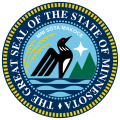| |||||||||||||||||
| |||||||||||||||||
| |||||||||||||||||
| Elections in Minnesota |
|---|
 |
The 1869 Minnesota lieutenant gubernatorial election was held on November 2, 1869, in order to elect the lieutenant governor of Minnesota. Republican nominee and former member of the Minnesota State Senate from the 11th district William H. Yale defeated Democratic nominee James A. Wiswell and Temperance nominee and former member of the Minnesota State Senate John H. Stevens. [1]

